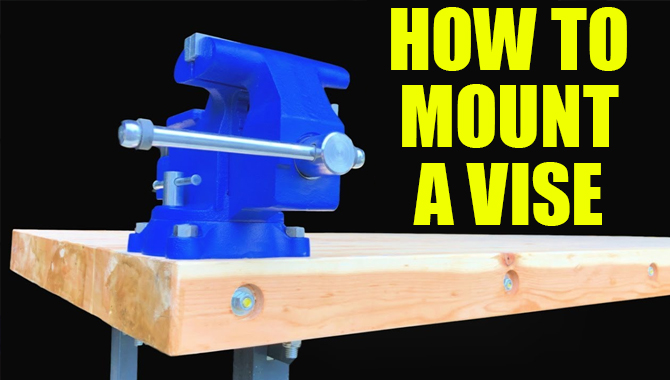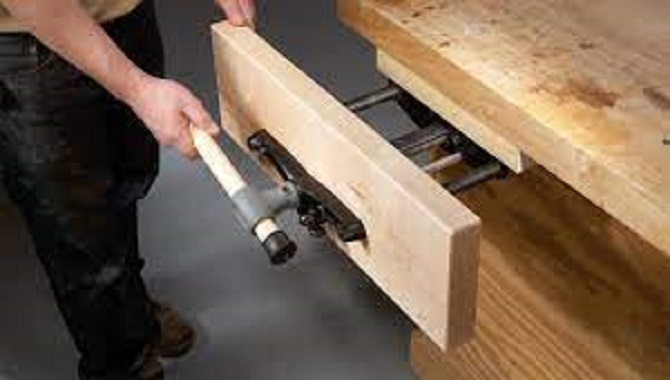A vice or Vise is a mechanical device used to hold an object to work efficiently on it. A Vise has 2 parallel jaws. One jaw is adjustable, and the other one is fixed. By utilizing a screw and lever, the movable jaw is pulled in and out.
A vise grip is a set of lever-operated grasping pliers. This is not a vise. So, how to mount a vise? The Vise can be permanently fixed to a workbench when it is used to hold a product during manual activities such as polishing, sawing, or hammering. So, proper mounting of a vise is very important. If you are uncertain of a vise mounting process, you are in the right hands. I will share each and every effective tip you can use to mount a vise.

Types Of Vise
There are 4 main types of Vise available. These are made from different materials and of different designs. Different Vise is used for different tasks. But their ultimate function is to hold a work object through their pliers. The various types of Vise are-
- Face Vise
- Engineer’s Vise
- Machine vise
- Pipe vise
Face Vise

This type of Vise is the most common type of woodworking vise. It is always firmly mounted to a workbench parallel with the working surface. Vise jaws are constructed of metal or wood, with the latter generally being fronted with wood, known as cheeks, to prevent tarnishing. A retractable jaw is sometimes included in the moveable jaw to hold the material against a bench.
A “fast-release” woodworker’s Vise is equipped with a bifurcated screw. The bifurcated nut enables the nut to connect or release with the handle’s half turn. When the moveable jaw is detached, it may be moved out or in across its complete motion range, greatly accelerating the adjustment procedure. Acme and buttress threads are common thread types.
Engineer’s Vise

This type of Vise is also called a machinist’s Vise, metalworking vise, or a bench vise. An engineers’ vise clamps metals rather than the woods. It’s used to maintain or hold metal in place when the metal is cut or being filed.
It is occasionally made of malleable cast iron or cast steel. However, most commonly cast iron is used to make an engineers’ vise. Engineer vise’s Jaws are frequently detachable and removable and are typically carved with grooved or jagged teeth. There is a Soft jaw covering of the engineers’ vise. To protect delicate work this soft covering is used.
This is made of copper, plastic, wood or Aluminum. An engineer’s Vise’s jaw opening is usually equal to the width of the jaw. Sometimes it is wider. An engineer’s Vise is fixed to a workbench’s top surface with the fixed jaw’s face just anterior to its front edge. Other features of the engineers Vise may have a small sized anvil on its body’s backside.
The majority of engineers’ vises feature a rotatable base. Some engineer’s vises are manufactured of low-quality iron or jar metal. Many bench vises used by homeowners feature a visible screw.
Machine Vise

Drill presses, milling machines, and grinding machines all have machine vises. A cam-actuated or coarse threaded machine-type Vise is integrated into abrasive cutting machines.
Pipe Vise

for threading and cutting tasks, this type of Vise is utilized by a plumber to hold pipes. These are 2 types: chain and yoke. The yoke clamps the pipe between 2 fixed inclined jaws at its base with a top-mounted screw; the chain type locks the pipe by encircling it inside a chain that adjusts in length per link and is tightened using a cam lever.
Uses of Vise
A vise is an important tool in wood and metalwork. Different types of Bench vises can be immediately mounted to a bench to secure the workpiece during certain tasks like arranging, sawing, and drilling. There are some important uses of Vise mentioned below-
When Using A Saw
A bench vise may be quite beneficial when using a saw to cut metal or wood for various DIY projects. If you use a vise, you will be able to hold the piece of material properly while cutting it.
When You Use A Drill
Do you require a drill for a project? To perform the drilling properly, choose a bench vise with a strong build. This drilling is a common activity involved in many fields such as plumbing, woodwork, and interior design, and electrical fittings. Drilling needs fundamental dependability and accuracy. A bench vise can be used to keep the drill machine in the correct spot to drill the holes.
For Metalworking Project
A bench vise is the greatest tool to use when working on metal. Numerous bench vises come with materials to cut a variety of metals. The other end of a metal item should be held tightly for an excellent cut toward one side. Bench vises are ideal for such applications.
For Woodworking Tasks
Glue is commonly used as a finishing touch in woodworking. There has to be an extra weight apart from gravity power to keep the parts united until they become dry. This task was commonly accomplished by laying heavy items on the parts until they adhered and dried correctly. You can use a bench vise to avoid unnecessary arrangements.
Taking Nails Out Of A Wood
Eliminating nails from a block of wood may be difficult since the wood must be held tight with a steady hand, and it takes a lot of power to pull, but it becomes much simpler if you use a vise.
Mounting A Vise
You will need some materials and tools if you are going to mount a vise. These are-
- Top washers
- Underside washers
- Bolts
- Nuts
- Lock washers
- Cordless drill
- Pencil
- Drill bit
- Wrenches
- Socket
Steps For Vise Mounting
- To begin, Place the Vise in your desired place. Now mark the vise mounting holes using a marker or pencil. It’s important to note that some vises include a template for mounting. If you are going to utilize the template that is included, you have to ensure that the template appropriately fits the base of the Vise. Sometimes they do not match up properly.
- Drill the mounting holes using an adequately sized drill. If you work on a plywood, be cautious not to give too much pressure. This excess force might lead the base to shatter when you cut through.
- Place a top washer over the openings on the base of your Vise as a trial. If the washer is too large, you may gently smooth down a section of the edge using a metal file or a bench grinder for a good fit.
- Now, over the holes, place the Vise. Set down a washer and then a bolt into the holes. If you encounter a fitting issue, make certain you make use of the washers that are adjusted.
- First, put a washer, then a lock washer, bolt on the bottom of one hole, and hand tighten. Repeat this for the remaining bolts.
- Tighten all the bolts with a socket wrench and a normal wrench to prevent the nut from rotating. You’ll want to get a good fit if you are working with timber or wood. Never make the bolts overtight. To verify if the bolts are equally tight, make another pass around them.
Conclusion
When setting your Vise, the fixed jaw should face just over the edge of the mounting table. This positioning will enable you to fasten lengthy components that will lie underneath the table surface. Right-handed people normally prefer to mount the Vise at the front right corner of the reloading or workbench. For lefties, use the left-front corner.
Put a flat steel plate in between the Vise and bench or beneath the bench for added support. I hope if you follow the mentioned steps properly, you will be able to mount a vise on your desired table. I hope now you understand how to mount a vise.
FAQs:
1. What Is The Best Way To Mount A Vise?
Ans: For mounting a vise, you have two main options: using screws or clamps. Screws are more permanent but may require additional adjustments down the road. Clamps offer more flexibility but can’t handle heavy objects as well. When mounting a vise, you have two main options: using screws or clamps.
When it comes to screwing mounting, vises come in a variety of shapes and sizes. So finding the right one for your needs can be tricky. Ultimately, it’s best to test out both types of mountings before making a final decision. Clamps are more flexible, but they can’t handle as much weight.
2. What Are Some Other Tips For Mounting A Vise Safely And Efficiently?
Ans: Here are a few other tips to help mount objects safely and efficiently:
- Always wear safety glasses when mounting an object.
- Make sure the vise you use is securely fastened before starting work.
- When mounting an object, be aware of your surroundings and use the correct mounting surface.
- You can purchase a preassembled universal vise at most hardware stores or online retailers.
3. How Do I Adjust The Tension On My Vise So That It’s Snug But Not Too Tight?
Ans: To adjust the tension on your vise, do the following:
- Tighten the tension by turning the vise clockwise.
- Loosen the tension by turning the vise anticlockwise. Please note: Turning the vise too much can cause it to become loose, and John Deere warns not to turn vises more than one full revolution. Additionally, over-tightening a vise may damage the metal parts.
4. How Do I Mount The Vise To My Workbench?
Ans: To mount the vise to your workbench, first secure it with screws. You can use mounting screws or T-bar nuts to do this. Make sure the screws or nuts are snugs before tightening. Next, place the vise so the jaws are perpendicular to the workbench. This will ensure that the vise is held securely in place. Finally, use the included screws or T-bar nuts to secure the vise to the workbench.
5. Can I Use A Vise To Hold Small Items Such As Screws And Nails?
Ans: Yes, a vise can be used to hold small items like screws and nails. To use a vise to hold screws, nails, and other small pieces of wood, check the vise for mounting accessories, such as screws or brackets. Once you have those, find the size and capacity of the vise that will best fit your project. Vises come in different sizes and capacities, so find one that will fit the needs of your project.

I am passionate about tools and electric work. I love finding new tools and experimenting with them.

